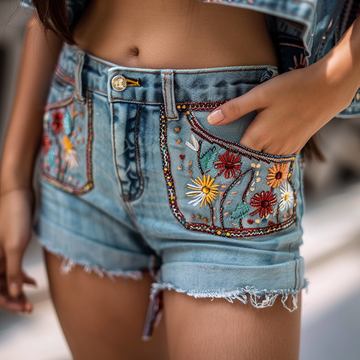Embroidering your clothes is a wonderful way to add unique, personal touches to your wardrobe. With a needle, thread, and some creativity, you can transform plain garments into customized pieces of art. Whether you're a beginner or an experienced embroiderer, here are some practical tips and ideas to help you get started.
Choosing Your Materials
Start with selecting the right materials. Choose a garment made from a fabric that's easy to work with, such as cotton or linen. These fabrics provide a stable base for your embroidery. For thread, use embroidery floss, which comes in a wide range of colors and is easy to handle. Make sure you have a selection of needles, an embroidery hoop, and some fabric stabilizer to keep your work neat and even.
Simple Designs for Beginners
If you're new to embroidery, start with simple designs. Flowers, hearts, and geometric patterns are great choices. Draw your design on the fabric using a water-soluble marker. This way, you can easily remove the markings once you're finished. Begin with basic stitches like the running stitch, backstitch, and satin stitch. These stitches are easy to learn and can be used to create a variety of designs.
Personalizing Your Clothes
Personalizing your clothes with embroidery allows you to showcase your style. Add your initials or name to the pocket of a shirt or the hem of a dress. You can also embroider meaningful symbols or quotes that resonate with you. For a more subtle touch, try adding small embroidered details to collars, cuffs, or pockets.
Embroidery Ideas for Different Garments
- T-Shirts and Tops: Add a small design near the neckline or on the sleeve. Flowers, stars, and abstract shapes work well for this.
- Jeans and Pants: Embroider along the side seams or around the pockets. Consider adding a floral vine or geometric pattern for a stylish touch.
- Jackets and Coats: Create a statement piece by embroidering a large design on the back. You could choose a mandala, an animal, or a landscape.
- Dresses and Skirts: Enhance the hemline or waistband with intricate patterns. Borders of flowers or lace designs look elegant and add a feminine touch.
- Accessories: Don’t forget accessories like hats, scarves, and bags. A small design on a hat brim or a corner of a scarf can make a big impact.
Adding Texture and Dimension
Add texture and dimension to your embroidery by using different stitches and layering techniques. The French knot, for example, creates a raised, textured effect that's perfect for flower centers. Layering different colors of thread can also add depth and interest to your designs.
Caring for Embroidered Clothes
Proper care will ensure your embroidered clothes last a long time. Always turn garments inside out before washing to protect the embroidery. Use a gentle cycle with cold water and mild detergent. Avoid using bleach or harsh chemicals. Line dry your clothes or use a low heat setting in the dryer to prevent damage.
Finding Inspiration
Look for inspiration in nature, art, and everyday life. Flowers, leaves, and animals provide endless design possibilities. You can also find inspiration in traditional embroidery styles from different cultures. Online platforms like Pinterest and Instagram are great places to discover new ideas and connect with other embroidery enthusiasts.
Getting Creative
Embroidering your clothes is not just about following patterns—it's about expressing your creativity. Experiment with different colors, stitches, and fabrics to create something truly unique. Don’t be afraid to make mistakes; each project is a learning experience.
Enjoying the Process
The process of embroidering can be relaxing and meditative. Take your time and enjoy each stitch. Whether you're embellishing a favorite piece of clothing or creating a special gift, the effort and love you put into your embroidery will shine through.





